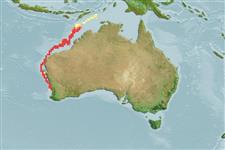Elasmobranchii (sharks and rays) >
Torpediniformes (Electric rays) >
Narcinidae (Numbfishes)
Etymology: lasti: Named for Dr. Peter R. Last, in recognition of his studies in the taxonomy and distribution of Australian elasmobranchs..
Environment: milieu / climate zone / depth range / distribution range
Ecology
Marine; demersal; depth range 178 - 350 m (Ref. 75154). Tropical; 8°S - 32°S, 111°E - 132°E (Ref. 114953)
Eastern Indian Ocean: Australia (Western Australia to off the Northern Territory) and Arafura Sea (SE Indonesia, south of Tanimbar I.).
Size / Weight / Age
Maturity: Lm ? range ? - 24 cm
Max length : 36.5 cm TL male/unsexed; (Ref. 93928)
Short description
Morphology | Morphometrics
This species is distinguished by the following characters: tail length as measured from cloaca much longer than disc width or length (means: tail length 53.7% of TL, vs. disc width 40.3% of TL and disc length 42.1% TL); nasal curtain much wider than long; colour pattern dorsally uniform light yellowish-brown, which is also present over preorbital snout region, no distinctive spotting or markings over disc and tail; low and inconspicuous lateral tail ridge, not resembling a distinct fold; mean preorbital snout length just over 10% of TL (Ref. 93928).
Usually found over sandy and muddy bottoms (Ref. 93928). Maturity size reaches at ca. 24 cm TL; born at ca. 7-8 cm TL. Biology little known (Ref. 114953).
Life cycle and mating behavior
Maturity | Reproduction | Spawning | Eggs | Fecundity | Larvae
de Carvalho, M.R. and B. Séret, 2002. Narcine lasti: a new species of numbfish from Western Australia and Indonesia (Chondrichthyes: Torpediniformes: Narcinidae). Rec. Western Australia Mus. 20:393-408. (Ref. 93928)
IUCN Red List Status (Ref. 130435)
Threat to humans
Harmless
Human uses
More information
Age/SizeGrowthLength-weightLength-lengthLength-frequenciesMorphometricsMorphologyLarvaeLarval dynamicsRecruitmentAbundanceBRUVS
ReferencesAquacultureAquaculture profileStrainsGeneticsElectrophoresesHeritabilityDiseasesProcessingNutrientsMass conversion
Tools
Special reports
Download XML
Internet sources
Estimates based on models
Preferred temperature (Ref.
123201): 13.2 - 17.5, mean 15.6 °C (based on 19 cells).
Phylogenetic diversity index (Ref.
82804): PD
50 = 0.5312 [Uniqueness, from 0.5 = low to 2.0 = high].
Bayesian length-weight: a=0.01175 (0.00476 - 0.02897), b=2.88 (2.66 - 3.10), in cm total length, based on LWR estimates for this (Sub)family-body shape (Ref.
93245).
Trophic level (Ref.
69278): 3.3 ±0.4 se; based on size and trophs of closest relatives
Resilience (Ref.
120179): Low, minimum population doubling time 4.5 - 14 years (Assuming fecundity<100).
Fishing Vulnerability (Ref.
59153): Low to moderate vulnerability (27 of 100).
